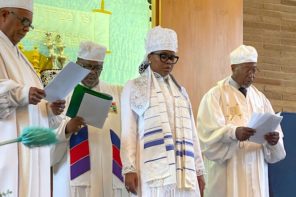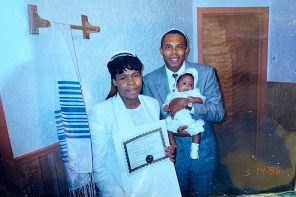Michelangelo’s iconic God the Father image, painted on the ceiling of the Sistine Chapel, draws on the Hebrew Bible’s patriarchal God tradition. In Deuteronomy 32:6 Moses explicitly refers to God as “your father” (avicha).
God the Father is front and center in Jewish and Christian liturgy. On Rosh Hashanah and Yom Kippur Jews direct their prayers to “Our Father, Our King” (Avinu malkenu). The Christian prayer “Our Father, Who Art in Heaven” (Pater noster qui es in caelis)—otherwise known as the Lord’s Prayer—was declared by Tertullian “the summary of the whole gospel.”
And yet the Hebrew Bible tells us this same God “convulsed in labor for you,” “gave birth to you,” and “suckled you” (Deuteronomy 32:13 and 18). Such contrasting images—of Divine Father and Divine Mother, just a few lines apart—suggest a dual-gendered deity. Why has no one written on this before?
In my book The Name: A History of the Dual-Gendered Hebrew Name for God (Wipf & Stock, 2020) I set out the case that the earliest worshippers of YHWH understood God to be a “male-female” deity. Reading the Hebrew Bible in a non-gendered language such as English, much (though not all) of this gets lost in translation.
In Hebrew, Moses addresses God in the second person masculine singular (attah) and the second person feminine singular (at). The original human being, the adam—created, according to the text, in God’s own image—is referred to as “them” (otam), which the rabbis took to mean an androgynous being only later separated by God into the male and female characters Adam and Eve.
Mothers and fathers in the Hebrew Bible retain more than a vestige of their dual-gendered origins. Eve—“the mother of all living”—is referred to as “he.” Mordecai—who takes Esther as his own daughter—is described as the young woman’s “nursing father.” Isaiah—extending the trope—prophetically declares that Israel’s future kings will be “nursing kings.” (Then, to be sure we don’t miss the point, Isaiah adds “kings’ breasts you shall suck.”)
All of the above—and many other examples which I cite in my book—are, I argue, hints to the closely-held priestly secret of the pronunciation and meaning of God’s “lost” name. YHWH—the so-called ineffable name of God, which some have guessed was pronounced Yahweh or Jehovah—is a cryptogram composed of the Hebrew pronouns “he” and “she.”
Swimming in the cultural currents of our time—feminism, gender revolution, and intersectionality—the idea of a dual-gendered God doesn’t strike many of us, as it would have struck most in previous generations, as blasphemous, or even strange. On the contrary, positive implications may spring to mind.
The idea of a dual-gendered God may be seen as a helpful corrective to the problem of conceptualizing God as male (as the feminist theologian Mary Daly wrote, “If God is male, then male is God”). So too, we may welcome a way of speaking about God which affirms people who identify as non-binary, gender-fluid, transgender, or otherwise genderqueer.
Moreover, reconceptualizing God in this “new-old” way (to borrow a term from the Zohar) may help disabuse us of the idea that our world is fundamentally dichotomous and hierarchal. Indeed, the metaphor may help us to appreciate the world’s differences as sitting in creative tension within a larger, all-embracing reality (a concept to which the philosophers gave the name coincidentia oppositorum, and which today is more often referred to by the term “integral”).
Of course, some may deem the dual-gendered God idea almost too convenient for the moment, too “politically correct.” If what I’m saying is true, why, they also may ask, has no one written on this before?
In fact, they have.
1540 was the year it was declared, according to one Kabbalistic tradition, not only permissible, but a mitzvah—a commandment—to teach Judaism’s mystical secrets openly to old and young alike in public. Just a few years later, a non-Jewish French scholar by the name of Guillaume Postel acquired some portion of the Kabbalistic work, the Zohar, from the printing house of Daniel Bomberg in Venice and began translating the work into Latin. Postel was arrested by the Vatican (not for translating the Zohar, but on a charge of heresy) and imprisoned for a time. Before 1566 he had written “The Treasure” (Le Thrésor des Prophéties de l’Univers) in which he wrote that the four-Hebrew-letter name of God YHWH was composed of the Hebrew pronouns “he” and “she.”
Fast forward to the nineteenth century. An Italian scholar by the name of Michelangelo Lanci wrote a book in which he, like Postel before him, claimed that the four-letter Hebrew name of God, YHWH, was composed of the Hebrew pronouns “he” and “she,” signifying a dual-gendered deity. Lanci’s book was banned by the Vatican which—unsurprisingly—considered it deeply heretical. But unlike Postel, in deference to his position, Lanci was not arrested. Father Lanci was the Vatican Librarian.
Postel’s work came to light again in 1969 through the work of the (ironically named) French scholar François Secret. More recently, Postel’s work has been cited by Robert J. Wilkinson (2015), and is the subject of two books by Judith Weiss (2016 and 2017). Father Lanci’s writings are, at the moment, less well-known, although they were covered in books—even a popular magazine article—published in America in the nineteenth century, as I recount in my book.
The secret of God’s name and dual gender has been an open secret for almost five hundred years. Only recently have feminism, the gender revolution, and intersectionality made the notion of a dual-gendered God seem both culturally possible and historically plausible.
As Harry S. Truman said “there is not really anything new, if you know what has gone before.”
Correction: The author originally stated the Postel’s book had been published in 1566 and that it came to light again in 1972. RD and the author regret the errors.





